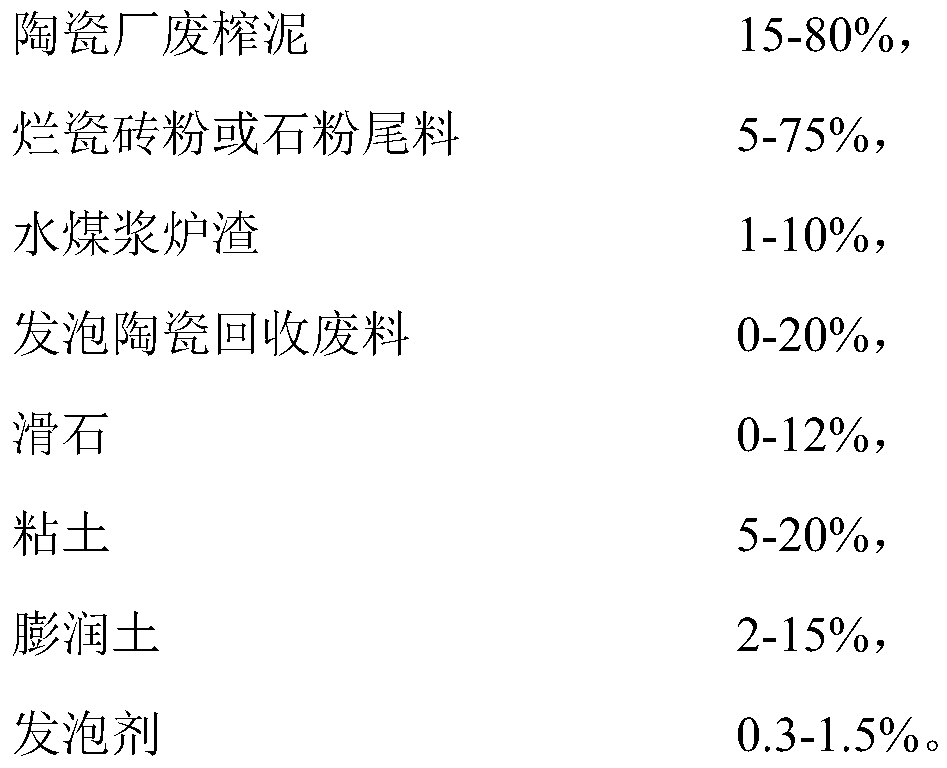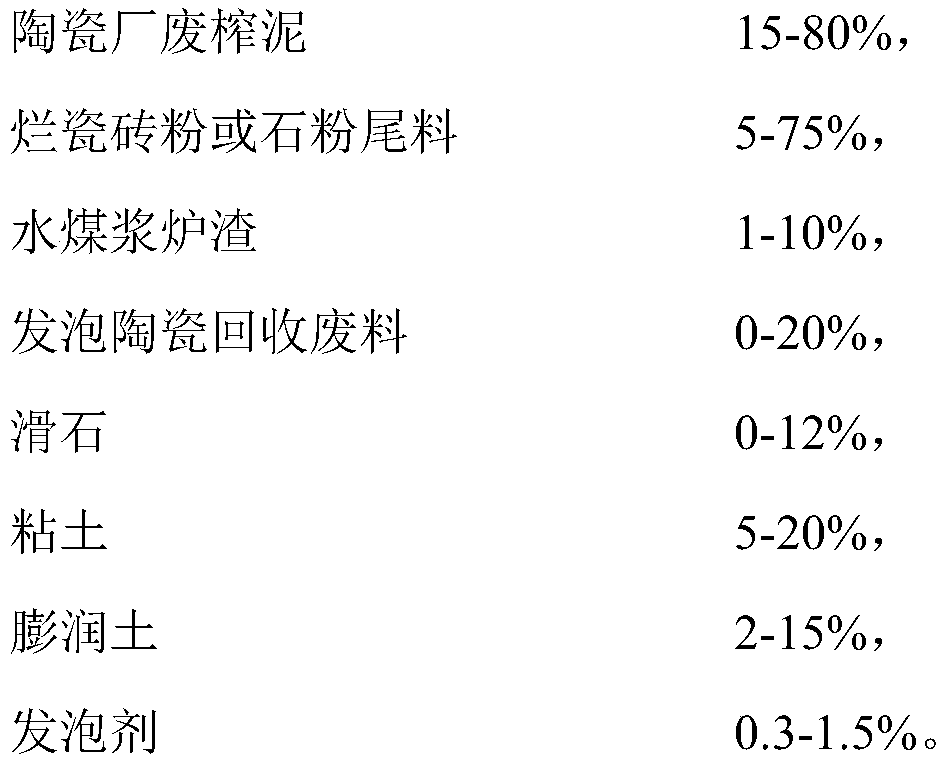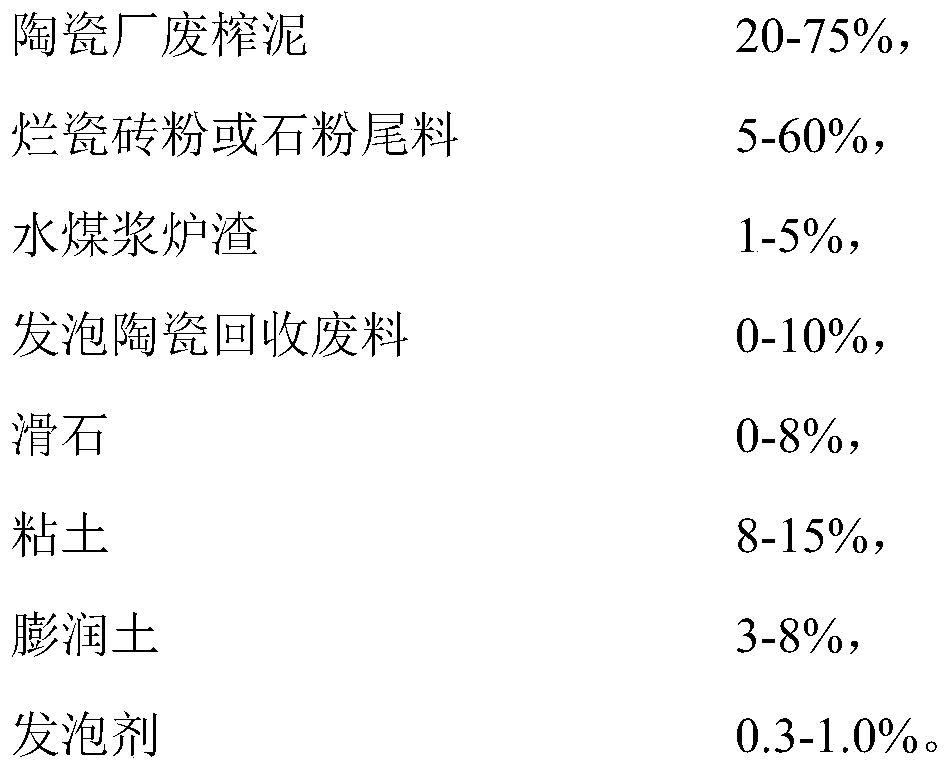Glazed ceramic decorative wall tile and manufacturing method thereof
A manufacturing method and technology of ceramic bricks, which are applied in the field of building ceramic materials and lightweight foamed ceramics, and can solve the problems of high total cost, waste of resources, environmental pollution, etc.
- Summary
- Abstract
- Description
- Claims
- Application Information
AI Technical Summary
Problems solved by technology
Method used
Image
Examples
Embodiment 1
[0061] A method for manufacturing ceramic glazed decorative wall tiles, comprising the following steps:
[0062] (1) In terms of percentage by weight, weigh and mix the following ceramic brick body raw materials, and then wet pulverize them with a ball mill to become foamed ceramic body mud. The moisture content of the mud is 35%, and the fineness is 250 mesh sieves Amount 1.4%;
[0063] The ceramic brick body includes the following raw materials: 73.1% of waste squeezed mud from ceramic factories, 5% of rotten tile powder or stone powder tailings, 1% of coal-water slurry slag, 2% of foamed ceramic recycling waste, 3% of talc, 10% of clay, Bentonite 5%, foaming agent 0.9%;
[0064] (2) carry out spray drying after described mud is passed through 80 mesh sieves, then pass through 16 mesh sieves and obtain the powdery blank that moisture content is 7.5%, standby after stale for 50 hours;
[0065] (3) According to the respective weight percentages of the three kinds of glazes, ...
Embodiment 2
[0075] A method for manufacturing ceramic glazed decorative wall tiles, comprising the following steps:
[0076] (1) In terms of percentage by weight, weigh the following ceramic brick body raw materials and mix them, and then wet pulverize them with a ball mill to become foamed ceramic body mud. The moisture content of the mud is 34%, and the fineness is 250 mesh sieves. Amount 1.5%;
[0077] The ceramic brick body includes the following raw materials: 64.3% of waste squeezed mud from ceramic factories, 10% of rotten tile powder or stone powder tailings, 2% of coal-water slurry slag, 3% of foamed ceramic recycling waste, 3% of talc, 12% of clay, Bentonite 5%, foaming agent 0.7%;
[0078] (2) Spray-dry the mud after passing through a 60 mesh sieve, then pass through a 14 mesh sieve to obtain a powdery base with a moisture content of 7%, and put it aside after stale for 50 hours;
[0079] (3) According to the respective weight percentages of the three kinds of glazes, weigh t...
Embodiment 3
[0089] A method for manufacturing ceramic glazed decorative wall tiles, comprising the following steps:
[0090] (1) In terms of percentage by weight, weigh and mix the following ceramic brick body raw materials, and then wet pulverize them with a ball mill to become foamed ceramic body mud. The moisture content of the mud is 33%, and the fineness is 250 mesh sieves. Amount 1.6%;
[0091] The ceramic brick body includes the following raw materials: 42.4% of waste squeezed mud from ceramic factories, 28% of rotten tile powder or stone powder tailings, 4% of coal-water slurry slag, 5% of foamed ceramic recycling waste, 3% of talc, 12% of clay, Bentonite 5%, foaming agent 0.6%;
[0092] (2) Spray-dry the mud after passing through a 50 mesh sieve, then pass through a 12 mesh sieve to obtain a powdery base with a moisture content of 7%, which is set aside after stale for 50 hours;
[0093] (3) According to the respective weight percentages of the three kinds of glazes, weigh them...
PUM
| Property | Measurement | Unit |
|---|---|---|
| Thermal conductivity | aaaaa | aaaaa |
Abstract
Description
Claims
Application Information
 Login to View More
Login to View More - R&D
- Intellectual Property
- Life Sciences
- Materials
- Tech Scout
- Unparalleled Data Quality
- Higher Quality Content
- 60% Fewer Hallucinations
Browse by: Latest US Patents, China's latest patents, Technical Efficacy Thesaurus, Application Domain, Technology Topic, Popular Technical Reports.
© 2025 PatSnap. All rights reserved.Legal|Privacy policy|Modern Slavery Act Transparency Statement|Sitemap|About US| Contact US: help@patsnap.com



